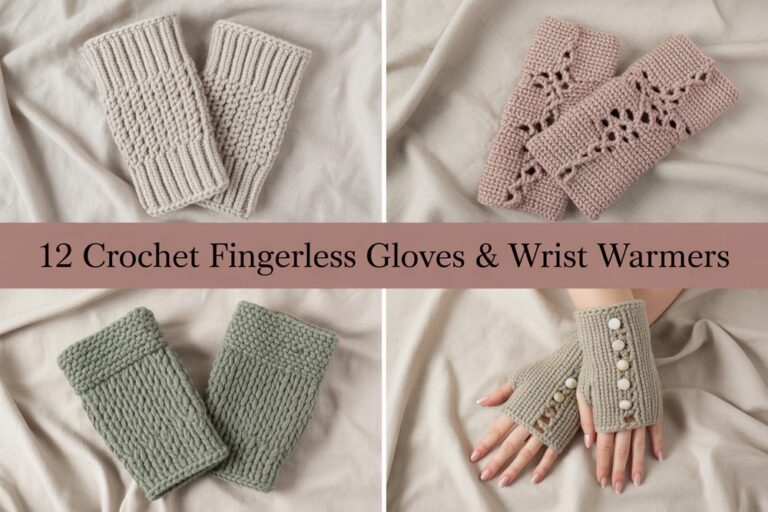8 Crochet Ribbon Bow Cardigan Ideas
Sweet, tied fronts and bow details make cardigans feel delicate, adjustable, and flattering across seasons. This collection focuses on designs that close with ribbons, cords, or bow ties—perfect when you want a feminine touch without buttons. You’ll find easy, photo-rich patterns with clear sizing notes, plus made-to-measure options if you prefer customizing as you go. Most use lightweight yarns for drape, though a couple lean cozy. Skim the captions for sizing tips, yardage notes, and a quick win you can start tonight. Each idea includes one solid tutorial link, so you can jump straight in with confidence.
Easy Pretty Bow (Lilith) Cardigan

A breezy, cropped layer with a dainty bow-tie front and scalloped edging. Panels are worked flat with a simple two-row repeat, then seamed—no shaping fuss. It’s written in seven sizes with fingering cotton for an airy drape; plan on ~1,040–1,620 yds depending on size. Tip: block lightly to sharpen the hem scallops, and mark tie placement with stitch markers before edging so both bows sit symmetrically. Start here if you want a polished spring/summer piece you’ll wear with dresses and jeans. Tutorial.
Supplies:
- Fingering (#1) cotton (e.g., DROPS Safran “Chalk”)
- Hook: 3.5 mm (E)
- Tapestry needle; stitch markers
Why it’s great: Light, feminine, and clearly sized with crisp step photos.
Triple Tie Cardi

A modern, drop-shoulder cardigan with three removable i-cord ties so you can wear it closed, partly tied, or open. Body is worked bottom-up with extended single crochet; sleeves are picked up and worked in the round. Nine sizes and clear yardage are provided (approx. 890–1,800 yds of DK). Tip: pre-cut i-cord lengths and test different placements before fastening ends, so the bows align with your natural waist. Cozy, adjustable, and beginner-friendly with video support. Tutorial.
Supplies:
- DK (#3) acrylic/wool blend (e.g., Wool-Ease DK “Slate”)
- Hooks: 5.0 mm (H) & 4.0 mm (G)
- Stitch markers; tapestry needle; scissors
Why it’s great: Size-inclusive with three video tutorials and customizable tie closures.
Crossover Wrap Cardigan

A flattering wrap with ties that secure around the back, featuring a simple dc body and lacy sleeves. The blog pattern includes step-by-step photos and a video for size M; written sizes run XS–5X. Sport-weight yarn keeps it drapey; the sample shows a soft pink vibe. Tip: pin your wrap’s tie path on the mannequin (or yourself) before adding edging, then place the ties so the crossover sits flat. Elegant but approachable. Tutorial.
Supplies:
- Sport (#2) merino/bamboo (e.g., Galileo “Apollo”)
- Hooks: 4.0 mm (G) & 4.5 mm (7)
- Stitch markers; blocking pins; measuring tape
Why it’s great: Feminine wrap fit with sleeves you can lengthen easily.
Flower Power Wrap Cardigan

This playful wrap uses Red Heart All-in-One Flower Power for built-in floral motifs and long ties; edging and ties are worked in a coordinating solid (Super Saver). Two size bands cover XS–3XL and the page includes care guidance. Tip: swatch the motif section first to learn the rhythm of i-cord ties and post-stitch ribbing, then adjust tie length before fastening—floral repeats shine when the wrap lies flat. Tutorial.
Supplies:
- Medium (#4) variegated acrylic + solid acrylic for trim
- Hook: 5.5 mm (I/9)
- Yarn needle; tape measure
Why it’s great: Eye-catching florals with simple construction and easy care.
Lacy Holiday Tie-Up Cardigan

A made-to-measure lace cardigan finished with a delicate front tie and clustered trim. The pattern uses weight-3 cotton with a subtle gold sparkle for festive glow that still works year-round. Because it’s sized to your body, yardage varies; the sample cites about 854 yds. Tip: keep notes on bust, armhole depth, and sleeve length as you go—custom measurements make the lace sit beautifully across the front. Clear photos plus a supporting video. Tutorial.
Supplies:
- DK (#3) cotton (e.g., 24/7 Cotton DK Sparkle “Star”)
- Hooks: 4.0 mm & 3.5 mm
- Stitch markers; measuring tape; tapestry needle
Why it’s great: Made-to-measure lace with an elegant, minimal tie.
Cozy Bow Cardigan

A soft, bow-front cardigan you size to your measurements. Panels use simple stitches; ties are added last (the blog notes ~47 cm strings). The sample uses a light (#3) alpaca/mohair blend—about 300 g for XS/S. Tip: because halo yarn can hide stitches, place markers every 10 rows and count by sections when seaming; you’ll get cleaner shoulders and even fronts. Great if you like gentle fuzz and custom fit. Tutorial.
Supplies:
- Light (#3) alpaca/mohair blend
- Hook: 6.0 mm
- Stitch markers; yarn needle; measuring tape
Why it’s great: Made-to-measure and cozy, with sweet bows that sit where you want.
Seaside Cardigan

A lightweight rectangle-based cardigan with an optional braided strap that wraps to cinch the waist—cute for beach evenings or everyday layering. It’s mostly double crochet in fingering cotton/acrylic; sizes S/M and L/XL are included with yardage (~1,526–1,744 yds). Tip: make the strap in a contrasting thread (the sample uses Aunt Lydia’s Size 3) so the bow pops and doesn’t stretch over time. Easy stitching, minimal seaming, breezy look. Tutorial.
Supplies:
- Fingering (#1) cotton/acrylic (Parchment)
- Hook: 4.0 mm
- Size-3 cotton thread for strap; tapestry needle; markers
Why it’s great: A true beginner garment with a charming wrap tie accent.
Ribbon Tie-Front Cardigan

Beginner-friendly panels, a simple three-row repeat (dc/dc/mesh), and a velvet ribbon you thread through the front to tie in a bow. The post lays out row counts and panel construction step by step, plus an easy single-crochet edging. Tip: seal ribbon ends with clear nail polish or fray check, then try the cardigan on before trimming so the bow tails fall evenly. Great fast make with a feminine finish. Tutorial.
Supplies:
- Worsted (#4) acrylic
- Hooks: 6.0 mm & 5.5 mm
- Velvet ribbon (~40 in); stitch markers; darning needle
Why it’s great: Instant charm—swap ribbons for holidays or outfits.
Conclusion
Pick one that matches your yarn drawer and timeline—Lilith for light cotton drape, Triple Tie for easy shaping, or the Ribbon Tie-Front if you want bows today. Ties make fit forgiving, so you can gift with confidence and skip buttonholes. Keep notes on measurements and tie placement, and block lightly for crisp edges. Save this collection for your next cozy weekend, and share it with a friend who loves a pretty bow.
FAQs
What yarns work best for bow-front cardigans?
Light cotton or cotton blends for spring drape; DK acrylic/wool for everyday wear; sport or fingering for delicate lace. Mohair/alpaca blends add halo but hide stitches—great look, slower counting.
Machine wash or hand wash?
Check the label. Cotton and many acrylics are machine washable (gentle, cool water). For blends or halo yarns, hand wash in cool water, squeeze (don’t wring), and lay flat to dry.
How do I scale patterns up or down?
Use the pattern’s size chart or try a made-to-measure option. Adjust panel widths by stitch multiple (noted in many posts) and add/subtract rows for length. Always swatch first.
What fibers are safest for kitchen/bath or heat?
Cotton handles moisture and light heat better than acrylic. Avoid direct heat on synthetics; they can melt. For steamy bathrooms, cotton or cotton blends are safer.
What joins/edgings last in daily wear?
Whip stitch seams are fine; mattress stitch looks neat. Add single-crochet or slip-stitch edging around fronts to reduce stretching, and reinforce tie points with small back-stitches.
Typical time and yardage for these cardigans?
Lightweight lace and fingering projects can run 1,000–1,700 yds and a few evenings to a couple weeks. DK versions often use 900–1,400 yds and work up faster. Ties add minimal yardage.
How do I photograph finished cardigans well?
Use indirect window light, a neutral background, and shoot waist-up. Tie bows neatly and steam lightly so edges lie flat. Include a close-up of stitch texture.
How do I fix curling, stretching, or wavy edges?
Curling: block and check hook size. Stretching: add a slip-stitch or sc edging; consider ribbing. Wavy edges: you may be adding extra stitches on edges—count and reduce evenly while edging.







